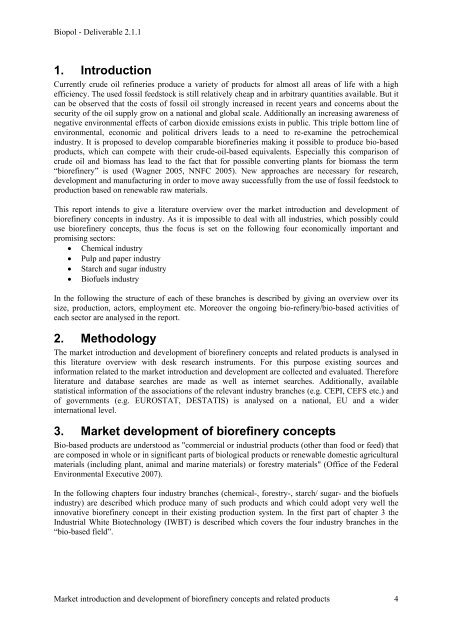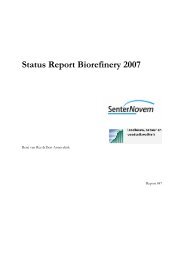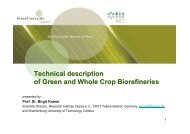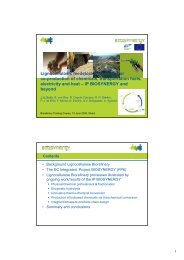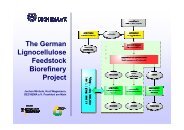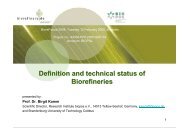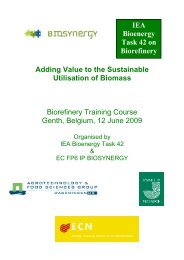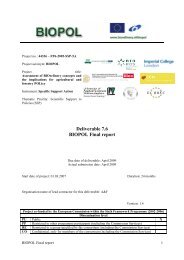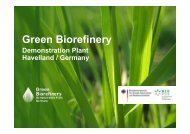D 2.1.1 Note on literature review concerning market ... - Biorefinery
D 2.1.1 Note on literature review concerning market ... - Biorefinery
D 2.1.1 Note on literature review concerning market ... - Biorefinery
Create successful ePaper yourself
Turn your PDF publications into a flip-book with our unique Google optimized e-Paper software.
Biopol - Deliverable <str<strong>on</strong>g>2.1.1</str<strong>on</strong>g><br />
1. Introducti<strong>on</strong><br />
Currently crude oil refineries produce a variety of products for almost all areas of life with a high<br />
efficiency. The used fossil feedstock is still relatively cheap and in arbitrary quantities available. But it<br />
can be observed that the costs of fossil oil str<strong>on</strong>gly increased in recent years and c<strong>on</strong>cerns about the<br />
security of the oil supply grow <strong>on</strong> a nati<strong>on</strong>al and global scale. Additi<strong>on</strong>ally an increasing awareness of<br />
negative envir<strong>on</strong>mental effects of carb<strong>on</strong> dioxide emissi<strong>on</strong>s exists in public. This triple bottom line of<br />
envir<strong>on</strong>mental, ec<strong>on</strong>omic and political drivers leads to a need to re-examine the petrochemical<br />
industry. It is proposed to develop comparable biorefineries making it possible to produce bio-based<br />
products, which can compete with their crude-oil-based equivalents. Especially this comparis<strong>on</strong> of<br />
crude oil and biomass has lead to the fact that for possible c<strong>on</strong>verting plants for biomass the term<br />
“biorefinery” is used (Wagner 2005, NNFC 2005). New approaches are necessary for research,<br />
development and manufacturing in order to move away successfully from the use of fossil feedstock to<br />
producti<strong>on</strong> based <strong>on</strong> renewable raw materials.<br />
This report intends to give a <strong>literature</strong> overview over the <strong>market</strong> introducti<strong>on</strong> and development of<br />
biorefinery c<strong>on</strong>cepts in industry. As it is impossible to deal with all industries, which possibly could<br />
use biorefinery c<strong>on</strong>cepts, thus the focus is set <strong>on</strong> the following four ec<strong>on</strong>omically important and<br />
promising sectors:<br />
• Chemical industry<br />
• Pulp and paper industry<br />
• Starch and sugar industry<br />
• Biofuels industry<br />
In the following the structure of each of these branches is described by giving an overview over its<br />
size, producti<strong>on</strong>, actors, employment etc. Moreover the <strong>on</strong>going bio-refinery/bio-based activities of<br />
each sector are analysed in the report.<br />
2. Methodology<br />
The <strong>market</strong> introducti<strong>on</strong> and development of biorefinery c<strong>on</strong>cepts and related products is analysed in<br />
this <strong>literature</strong> overview with desk research instruments. For this purpose existing sources and<br />
informati<strong>on</strong> related to the <strong>market</strong> introducti<strong>on</strong> and development are collected and evaluated. Therefore<br />
<strong>literature</strong> and database searches are made as well as internet searches. Additi<strong>on</strong>ally, available<br />
statistical informati<strong>on</strong> of the associati<strong>on</strong>s of the relevant industry branches (e.g. CEPI, CEFS etc.) and<br />
of governments (e.g. EUROSTAT, DESTATIS) is analysed <strong>on</strong> a nati<strong>on</strong>al, EU and a wider<br />
internati<strong>on</strong>al level.<br />
3. Market development of biorefinery c<strong>on</strong>cepts<br />
Bio-based products are understood as "commercial or industrial products (other than food or feed) that<br />
are composed in whole or in significant parts of biological products or renewable domestic agricultural<br />
materials (including plant, animal and marine materials) or forestry materials" (Office of the Federal<br />
Envir<strong>on</strong>mental Executive 2007).<br />
In the following chapters four industry branches (chemical-, forestry-, starch/ sugar- and the biofuels<br />
industry) are described which produce many of such products and which could adopt very well the<br />
innovative biorefinery c<strong>on</strong>cept in their existing producti<strong>on</strong> system. In the first part of chapter 3 the<br />
Industrial White Biotechnology (IWBT) is described which covers the four industry branches in the<br />
“bio-based field”.<br />
Market introducti<strong>on</strong> and development of biorefinery c<strong>on</strong>cepts and related products<br />
4


